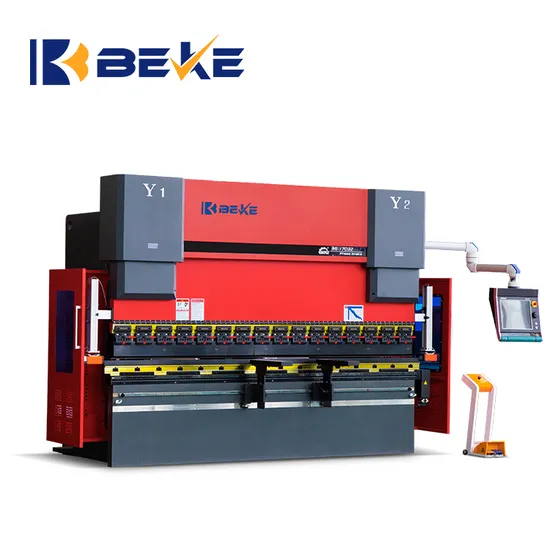
Beke Press Brake 200t 3200mm We67K Series CNC Press Brake
Basic Info.
Condition
New
Certification
CE
Automation
Automatic
Suitable for
Aluminum, Carbon Steel, Stainless Steel
Type
Press Brake
Weight
12000kg
Model
We67kda69t 170t3200
Pressure
200ton
Max Bending Length
3200mm
Max Bending Thickness for 3m Sheet
8mm
Column Distance
2600mm
Slide Stroke
200mm
Max Opening Height
480mm
Throat Depth
400mm
Main Motor Power
15kw
Axes
Y1 ,Y2, X1, X2, R1, R2, Z1, Z2
Transport Package
Container
Specification
3900x1900x2600mm
Trademark
BEKE
Origin
China
Product Description
Product Description
Packaging & Shipping
Company Profile customer
| An electric-hydraulic press brake is a mechanical device used for metal sheet processing, primarily for bending or folding metal sheets. It utilizes an electro-hydraulic hybrid drive system, combining hydraulic and electrical control systems to achieve high-precision bending operations. An electric-hydraulic press brake typically consists of the following main components: Frame: The frame of the electric-hydraulic press brake is usually made of a sturdy welded steel plate, providing sufficient strength and stability to withstand the pressure and vibrations during the machining process. Worktable: The worktable is a platform used for placing and securing the metal sheets. It is typically made of a robust steel plate and equipped with fixtures and clamping systems to ensure the stable and accurate positioning of the metal sheets during the bending process. Ram: The ram is the moving component of the electric-hydraulic press brake, which performs vertical up and down movements driven by hydraulic cylinders or servo motors. The ram is usually fitted with bending tools or dies to apply pressure on the metal sheets and achieve the bending operation. Hydraulic system: The hydraulic system is a critical part of the electric-hydraulic press brake, providing power and controlling the vertical movement of the ram. The hydraulic system consists of hydraulic pumps, hydraulic cylinders, hydraulic valves, and hydraulic oil tanks. The hydraulic pump pushes hydraulic oil into the hydraulic cylinder to drive the movement of the ram. Electrical control system: The electric-hydraulic press brake is also equipped with an electrical control system, which monitors and controls the machine's operation. The electrical control system typically includes buttons, switches, programmable controllers, and displays, allowing for programming and setting of bending angles, pressure, and speed parameters to achieve automated bending operations. The electric-hydraulic press brake offers easy operation, high precision, efficiency, and wide applicability to different types of metal sheets. It is widely used in various industries such as manufacturing, aerospace, automotive, and construction, within the metal sheet processing sector. |
>> Ahyw Ywgs Hydraulic Metal Shearing Cutting Machine
>> aluminium profile frameless sliding windows for ghana
>> Nordic Garden Carts Outdoor Folding Pushchair Portable Camping Wagon Picnic Stall Wheels Trolley Shopping Cart Fishing Trolley Wagon
>> For BMW 3 Series F30F35 change GTS Engine Cover
>> China Factory Offer Folding Portable Display Counter
>> Rubber Floor Tile Vulcanizer for Gym Sports Rubber Flooring Mat Making Machinery
>> Pto Shaft for Kubota John Deere Tractor
>> Forklift Parts Ignition Switch Used for J02 25150-20h01
>> OEM/ODM Factory Wholesale Waterproof Rechargeable Travel Smart Whitening Personal Care Power Sonic Battery Electric Toothbrush
>> portable small fishing rod black zoom popping dif fishing rod production line
>> Plastic Bottle Recycling Line Plastic Bottle Recycle Machine
>> Women Mini Hand Bag Leather Double Strap Shoulder Bag Small Purse Wyz16985
>> Apatite Ore Impact Crusher Aggregate Rotary Impact Crusher
>> China Factory Price 8PCS Non Stick Ceramic Coating Induction Bottom Aluminum Cookware
>> Luxury Lady Handbag Replica Handbag PU Handbag Leather Boston Bag
>> Ailusi Reactor High Shear Mixer Stainless Steel Paste Vacuum Emulsifier Body Lotion Cosmetic Toothpaste Toothpaste Making Machine
>> 140DAI55300 CPU module
>> Mosaico Vetricolor Pool Tile Piscina Mosaico Vitreo
>> Black Heavy Duty Square Tube Dog Cage with Flat Top
>> Low Loss 500kVA 11kv 0.4kv 0.415kv Oil Immersed Distribution Power Transformer
>> Taijia CM series Chrome Coating, Concrete Thickness Gauge
>> OEM cashmere sweaters cardigans
>> ASTM D1122 Density of Engine Coolants Tester
>> X One Se Body Analyzer BMI Machine Fat Body Index Analyzer
>> Customized Steel Bumper Auto Metal Front Bumper
>> Kinds of Color Leather Fabric for Coating Bags
>> Plastic PE Large Rolling Trash Polythene Garbage Polythene Bag Making Machine
>> Zinc plated HVAC damper hardwares / air fittings for ductwork system
>> School Clothes Child Primary School Uniform
>> ZX50C Vertical Drilling and Milling Machine with Swivel Head